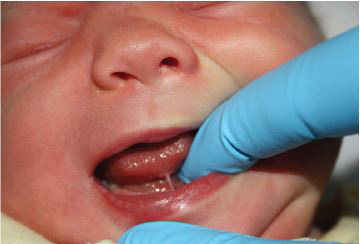Tongue-tie release is a very simple procedure, particularly in babies under six months of age. The procedure only takes a few seconds and does not require an anaesthetic (medicines used to numb sensation in certain areas of the body or induce sleep). Babies are likely to cry immediately after the procedure, although the majority of babies cry for less than a minute.
The use of tongue-tie release to improve feeding is supported by the National Institute of Clinical Excellence (NICE). It is considered a safe and simple procedure which demonstrates significant improvements in feeding, particularly breastfeeding, where a reduction in nipple pain and an improved ability to latch on to the breast has been consistently identified.
Before the procedure
If we recommend that your baby has the procedure, we will discuss it with you in more detail and ask for your consent.
Your baby must have had either the Vitamin K injection or the second dose of oral drops (if they are having oral Vitamin K) more than 24 hours before the procedure.
You will also need to confirm that your baby is fit and well with no known medical conditions at the time of their feeding assessment. If you or your baby’s father has a blood clotting disorder, or there is a family history of blood clotting disorders, please discuss this with us during your baby’s feeding assessment.
During the procedure
- We will wrap your baby securely in a blanket and hold them gently to keep their head still. Some babies may not like this.
- We will then release the tongue-tie using sterile, round-ended scissors. We will then apply some pressure under your baby’s tongue to stop any bleeding using a piece of sterile gauze. There will usually only be a few drops of blood.
- Once we have released the tongue-tie, we will unwrap your baby and encourage them to feed straight away. This will help your baby’s tongue to move and may prevent the tongue-tie from re-fusing.
You may remain with your baby for the duration of the procedure or, if you prefer, your midwife can take your baby to a separate room.
We will support you to feed your baby after the procedure. We will also discuss a management plan with you to help you with your ongoing feeding experience.
The decision to have your baby’s tongue-tie released is a personal one. If you choose not to have the procedure, we will continue to give you feeding support. If at a later date you are concerned about your baby’s feeding, please contact your health visitor or GP. They can refer you for another tongue-tie assessment.
After the procedure
A small white blister may develop under your baby’s tongue in the first couple of days after the procedure. As far as we can tell, this is painless and does not interfere with feeding.
Your baby may be fussy and unsettled for a few days after the procedure. It may also take a few weeks before your baby is fully comfortable when feeding. Occasionally, the procedure may not improve a baby’s ability to feed.
Possible risks
As with any surgical procedure, there are some possible risks, but these are rare. Risks include:
- excessive bleeding
- infection
- ulcers
- pain
- damage to the tongue and surrounding tissues
Very occasionally, a tongue-tie may reoccur if the frenulum re-fuses. This may be due to residual frenulum or the development of scar tissue. If this happens, a further procedure may be necessary.
We will explain these risks to you in more detail before you agree to the procedure.
The future
Occasionally, tongue-ties can persist and while the majority of children have no difficulties with their speech, the presence of a tongue-tie has been shown to influence the ability to pronounce certain sounds in some children. However, it is impossible to predict which children will be affected, or to determine whether treatment as a baby will prevent this.
Speech difficulties are usually noticeable by the time a child reaches three years of age. If you think your child’s speech is affected or they are having problems caused by tongue-tie, contact your GP or health visitor and they will be able to refer your child to a speech and language therapist for an assessment.




 This page explains what a tongue-tie is, what the implications of a tongue-tie are for both you and your baby, and what treatment options are available. We hope it will help to answer some of the questions you may have. If you have any further questions or concerns, please speak to a member of your healthcare team.
This page explains what a tongue-tie is, what the implications of a tongue-tie are for both you and your baby, and what treatment options are available. We hope it will help to answer some of the questions you may have. If you have any further questions or concerns, please speak to a member of your healthcare team.